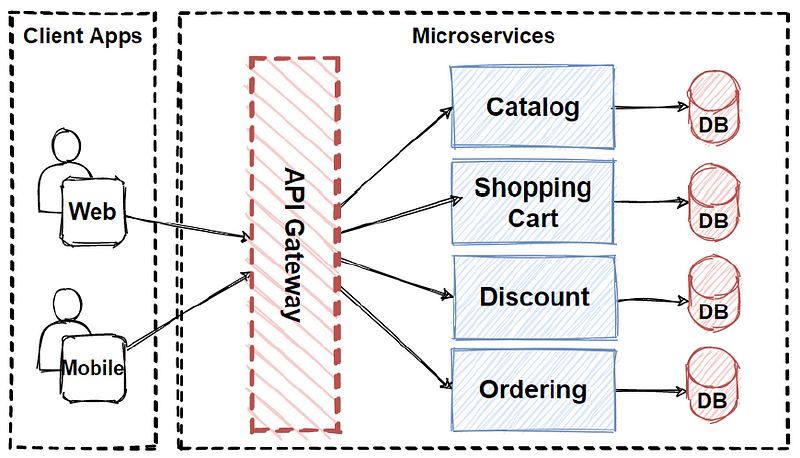
Introduction:
The API Gateway pattern has emerged as a pivotal architectural approach in the realm of microservices, providing a streamlined communication channel between client applications and the underlying services.
This pattern serves as a facade or proxy, simplifying interactions for clients while orchestrating complex operations on the backend.
In this blog post, we will delve into the intricacies of the API Gateway pattern, exploring its benefits, challenges, and strategies for overcoming potential pitfalls.
Understanding the API Gateway Pattern:
At its core, the API Gateway pattern revolves around the concept of a single endpoint acting as the sole communication gateway for client applications. This centralized point of entry not only simplifies client interactions but also serves as a strategic location for implementing various cross-cutting concerns. Let’s explore the key features and functionalities embedded within this pattern:
- Reverse Proxy Mechanism: The API Gateway employs a reverse proxy mechanism in the backend, efficiently routing client requests to specific microservices. This enhances flexibility and modularity, allowing for the seamless addition or removal of services without impacting the client.
- Response Aggregation: One notable capability of the API Gateway is its ability to aggregate responses at the gateway level. Clients send a single request to the API Gateway, which then makes internal requests to various services, performs operations, and consolidates the results before returning them to the client. This minimizes the number of requests made by the client and optimizes overall system performance.
- Cross-Cutting Functionality: The API Gateway serves as a centralized hub for implementing cross-cutting functionalities, including:
- Authentication: Verifying the identity of users or systems to ensure they have the necessary credentials or permissions to access the services.
- Authorization: Determining whether authenticated users or systems have the required permissions to perform specific actions or access certain resources.
- Rate Limiting: Controlling the number of requests a client can make within a defined time period to prevent abuse, protect resources, and maintain system stability.
- Throttling: Regulating the rate at which requests are processed, preventing overload on services and maintaining a balanced distribution of resources.
- Service Discovery: Facilitating the dynamic detection and registration of services within the network, allowing the API Gateway to adapt to changes in service availability.
- Caching: Storing frequently accessed data or responses to reduce the load on backend services, improve response times, and enhance overall system performance.
- Circuit Breaker, Retry Policy, Quality of Service (QoS): Ensuring system robustness by implementing mechanisms like circuit breakers to prevent cascading failures, defining retry policies for resilient communication, and maintaining a specified quality of service.
- IP Whitelisting: Restricting access to the API Gateway based on the IP addresses of incoming requests, enhancing security and controlling the sources of traffic.
- Logging: Recording and monitoring relevant information about requests, responses, and system behavior to facilitate debugging, auditing, and analysis.
- Header and Query Modifications: Dynamically altering request and response headers as well as query parameters to meet specific requirements, adapt to changing conditions, or enforce standards across services.
In summary, these cross-cutting functionalities collectively contribute to the reliability, security, and performance optimization of a microservices architecture by consolidating common features within the API Gateway.
To understand above explained theory better i am attaching one diagram for you to understand better.

Challenges and Solutions:
While the API Gateway pattern offers numerous advantages, it comes with the inherent risk of becoming a single point of failure for the entire system.
To mitigate this challenge, we can implement multiple API gateways. These gateways, differentiated by business logic, provide redundancy and fault tolerance. This approach, also known as the Backend for Frontend (BFF) pattern, ensures that the system remains resilient even in the face of potential gateway failures.
Backend for Frontends(BFF) Pattern
The above solution can be understand by the following diagram. So rather than providing one big API for all kind of clients here BFF comes into picture. BFF pattern provide different APIs for different type of clients.

Anti-Pattern Alert:
We can concludes with a cautionary note about avoiding the anti-pattern of using a single API gateway for an ever-expanding array of services. This practice can lead to performance bottlenecks, increased complexity, and heightened susceptibility to failures.
Instead, the recommendation is to embrace the scalability and flexibility offered by a multi-gateway approach, aligning with the principles of microservices architecture.
Simply put, the API Gateway pattern, when used wisely, becomes a crucial element for coordinating microservices, improving security, boosting performance, and ensuring the reliability of a distributed system.